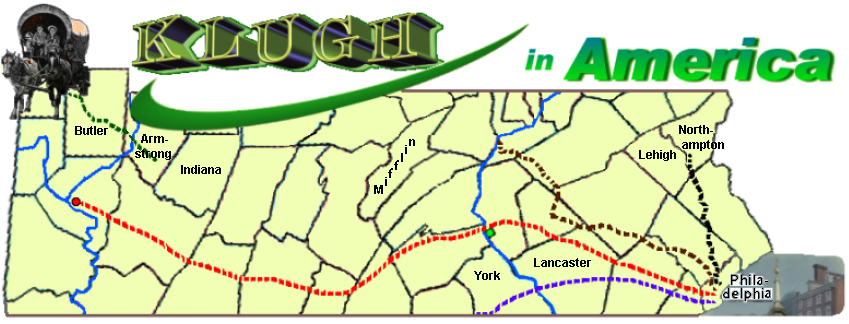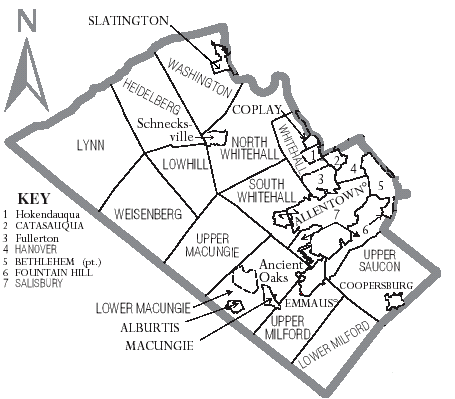
Lehigh County - A Brief History
It's not my intent to get bogged down with too much detail about this-and-that concerning historical data. With that in mind, I offer the following.
"It is both interesting and instructive to study the history of our fathers, to fully understand [the] difficulties, obstacles, toils and trials they went through to plant settlements [and how they] struggled up to a position of wealth and prosperity."1
The people indigenous to the Lehigh valley area, which is in the Kittatinny valley were the Minsies (Delaware) tribe. Kittatinny valley lay between the South Mountains on the south and the Blue Mountains on the north. The first purchase of land was made in 1682 by William Markham, Deputy Governor of the colony. The second and third purchases were made by William Penn and Chief Macungie (Maughaugsin), the first in 1684 and the second in 1686 and was for two matchcoats, four pair of stockings and four bottles of cider (spelled "sider"). In addition to receiving the matchcoats, stockings and cider, Chief Macungie promised not to molest the Christians and they would move beyond the Blue Mountains in the north. The purchase of 1686 was said to include all the land beginning at the line set by the 1684 purchase and extend as far northwest as a man could ride in two days. This was eventually contested by the Indians many of whom decided to stay in the area. The Indians said they would trade as much land as could be walked in one day. It was known as "The Walking Purchase."
The word "Lehigh" comes from "Lechaweki" and is the Indian name for the river. It means where the way makes a fork. It was later shortened to "Lecha" by the Germans and later to "Lehigh".

The first white men to come to the area in the 1600s were traders. The first settlement was made in 1730. German settlers arrived in 1734. By 1740 very few Indians remained. The population in 1752 was 2800 people, part of which were: 700 in Milford; 650 in Upper Saucon; 800 in Whitehall.
The Indians were still unhappy with how much land was taken and the first Indian raid upon the settlers was in 1755. It was duing such a raid that Moravians were massacred. Another raid occured in 1763 by Chief Pontiac. Many whites sought refuge in Bethlehem. In 1763 Jacob Alleman's wife and child and [another] boy and girl were killed and scalped. Many farms in South Whitehall were laid-waste. Some white children were captured by the Indians and lived in captivity with them as long as seven years.
When the schools were first opened the students were taught in German. The first entirely English school was established at Egypt in 1809. The first school in the County was established in 1725 by the Swamp church in Lower Milford township. The Mennonites opened a school in Upper Milford in 1735 and the Lutherans opened a school in 1743. The Moravians opened a school in Emaus in 1746 but was moved to Bethlehem in 1753 due to trouble with the Indians.
By 1773 much land had been cleared: Upper Milford - 7,096 acres, Macungie - 6,459, Whitehall - 6,070, Upper Saucon - 5,792, Lynn - 3,412, Heidelberg - 2,905, Salisbury - 2,400, Weisenburg - 2,179, Lowhill - 1,131, plus much more land for growing grain, plus 180,000 acres of wooded land.
The farmers of the day used rye bread and buckwheat cakes but sometimes used white bread. The farmers also grew wheat, rye, corn, oats, barley, buckwheat, and potatoes. The principal industries are cotton and woolen, boot and shoe, silk and knitting, hardware, cutlery, breweries, furnaces, foundries, flour mills, tobacco, and cement. There is also farming, mining, dairying and trucking.
The first great flood of the area occured in October of 1786. The next was in 1841 and then again in 1862 and 1869 and in February of 1902. During the last flood the Little Lehigh and Jordan Creeks overflowed their banks. The bridges across the Lehigh River at Allentown and the Central Railroad bridge across the Lehigh River at Kline's Island were swept away.
Laborers were paid ten to twelve cents per day. Rent for a house was $4.00 - $8.00 per year and included several acres of land.
The first election was held on October 30th, 1812.
At the time of the Revolutionary War, Lehigh County was still part of Northampton County. The County formed a Company of men that was part of the 2nd Pennsylvania Battalion called "The Flying Camp".
George Washington set the General Hospital of the Army at Bethlehem. The State House bell was moved from Philadelphia to Allentown for concealment after the British took possession of Philadelphia.
Approximately 1,000 men killed in the Revolutionary war were buried in what is now West Bethlehem on "this side of Monocacy Creek and on the right side of the road, leading to Allentown."
There is one incident of an insurrection during the Revolutionary war over laws that were passed concerning alien and sedition and tax laws. Some violators were caught and held prisoner in the Sun Hotel. Others were fined and/or imprisoned.
The inhabitants of Lehigh County also helped out during the War of 1812 and the Mexican war of 1845-48. They didn't have to do so again until the Civil War when 2,063 men served from Lehigh County: 83 were killed, 64 wounded, 257 captured, and 49 MIA.
The population of Lehigh County in 1830 was 22,256. In 1890 it was 93,893.
The animals in the county are: red and grey foxes, raccoon, mink, rabbit, opossum, woodchuck, skunk, cat, flying and ground and red and grey squirrel, chipmunk and weasel. Birds are: the eagle, turkey buzzard, screech and great horned owl, fish hawk, heron, whipporwille, night hawk, mocking bird, swallow, quail, blue bird, black bird, crow, robin, gold finch, oriole, wren, jay, crane, cat bird, and sparrow.
The principal formations of rock of the different townships of Lehigh County are: Hanover - shale, slate and limestone; Heidelberg - shale and slate; Lower Macungie - syenite and limestone; Lower Milford - red sand, stone and syenite; Lowhill - shale and slate; Lynn - shale and slate; North Whitehall - shale and limestone; Salisbury - syenite, quarizite and limestone; Upper Milford - shale and slate; Upper Saucon - red sandstone, syenite and limestone; Washington - shale and slate; Weisenberg - shale and slate; Whitehall - shale and slate.
Religions: Protestant Episcopal, Lutheran (church founded in 1757), Reformed, Great Swamp Church (part of Reformed, founded between 1725-1730), Baptist, Presbyterian, Methodist Episcopal, Evangelical Association, United Evangelical, United Brethren, Mennonite (founded in 1735), Mennonite Brethren in Christ, Free Methodist, Sweden-borgian, Catholic and Moravian.
The highest point in Heidelberg township is Bake Oven Knob on what is now the Appalachian Trail (the creator of this website has been there many times).
Emaus was founded in 1747; Allentown in 1762 by James Allen; Macungie in 1776; Fountain Hill in 1850; West Bethlehem in 1869.
References:
1. A History of Lehigh County, Pennsylvania (on CD), by James J. Hauser - 1902 - Emaus, Pennylvania.
(c) July 4, 2011: (All rights reserved)